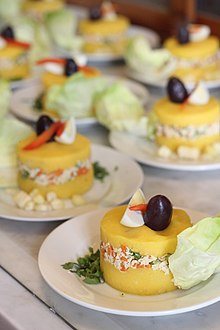Causa limeña
 | |
| Course | Entrée |
|---|---|
| Place of origin | Peru |
| Region or state | Coast |
| Serving temperature | Cold |
| Main ingredients | Potato, chilli pepper, lemon, Mayonnaise, avocado, chicken or tuna, varied vegetables. |
Causa limeña or simply causa,[1] is a typical and widespread entrée of the Peruvian gastronomy which has a pre-Columbian origin.[2]
History[]
In the ancient Peru, it was prepared with yellow potatoes, which have a soft texture, and kneaded with crushed chilli peppers, although it can also be made with any other variety of potato. During the Viceroyalty era, between the 16th and 19th centuries, lemon (originally from Asia)[2] was added, reaching the modern form, in both the ingredients and the presentation.
Etymology[]
There are many hypotheses about the name of the dish. Firstly it was suggested that it comes from the quechua Kawsay, which means "necessary sustenance" and "food", or "what feeds", a name also given to the potato.[3][4]
There are other hypotheses about the name of the dish that link it to war episodes of the contemporary history of the Andean country. Even though this clearly Limean dish exists since the Viceroyalty, it didn't have a specific name; it was with the arrival of the libertador José de San Martín that, in order to solve the expenses of the military campaign, this dish was sold in the corners of the Limean streets, as a way to contribute to the cause (por la causa in Spanish, "for the cause").[5][6] On the other side, it may also be possible that causa limeña was a patriotic dish during the Peruvian-Chilean Pacific war. At the time, women would help the soldiers by offering them this cold dish.[7]
While this dish is called causa in Lima, in the northern city of Trujillo the name is used to designate any spicy meal,[3] even if causa limeña is also prepared in this city and is as good as the capital one. [4]
Description[]
This dish is traditionally made with yellow potato, lemon, boiled egg, yellow chilli pepper and black olives.[8] It also may have avocado for the stuffing and lettuce for decoration purposes. The preparation admits many variants, like the causa filled with tuna, trout, ,[9]chicken, shellfish or other white meat. It is served with a light bath of mayonnaise.
Apart from yellow potatoes, the dough can also be made with lima beans or yellow yucca.[10]
See also[]
References[]
- ^ "Historia de la culinaria peruana - Causa (plato peruano)". sites.google.com.
- ^ Jump up to: a b Fetzer, Erika (2 April 2004). Sabores del Perú: la cocina peruana desde los incas hasta nuestros días (in Spanish). Viena. p. 37. ISBN 9788483302491. Retrieved 29 October 2018.
- ^ Jump up to: a b Tam Fox, Aída (1 January 2010). Vocabulario de la cocina limeña: historia y tradición (in Spanish). Casa del Libro Viejo. p. 91. ISBN 9786124533662. Retrieved 19 October 2018.
- ^ Jump up to: a b Coloma Porcari, César (23 February 2004). "Una buena causa". El Comercio. Lima. p. e-2. Retrieved 29 October 2018.
- ^ "Causa a la limeña: conozca la historia de este platillo nacional". Panamericana Televisión (in Spanish). 7 July 2013.
- ^ Moreira, Marta (24 March 2017). "Todo sobre la causa limeña, el plato de la revolución nacional peruana que nos vuelve locos". Guía Hedonista (in Spanish).
- ^ "Causa con sabor a Perú". La República. 27 July 2017. Retrieved 11 February 2019.
- ^ Carrillo, Enrique (1905). Cartas de un turista (in Spanish). Lima: Imprenta La Industria.
justo es decir, sin embargo, que algunos de ellos tienen grato sabor y atractivo aspecto; y que una causa amarilla y jugosa rodeada de negras aceitunas y menudas tajadas de huevo duro y coronada por un hermoso ají rojo, es un manjar exquisito y que grita: comedme
- ^ Hinostroza, Rodolfo (2006). Primicias de cocina Peruana (in Spanish). León (España): Everest. p. 148. ISBN 84-241-1480-9. Retrieved 9 February 2018.
- ^ Acurio, Gastón (2008). Larousse de la gastronomía peruana: diccionario gatronómico ilustrado (in Spanish). Lima: Q.W. Editores. p. 84. ISBN 9789972589379. Retrieved 15 June 2019.
External links[]
- Potato dishes
- Appetizers
- Peruvian cuisine